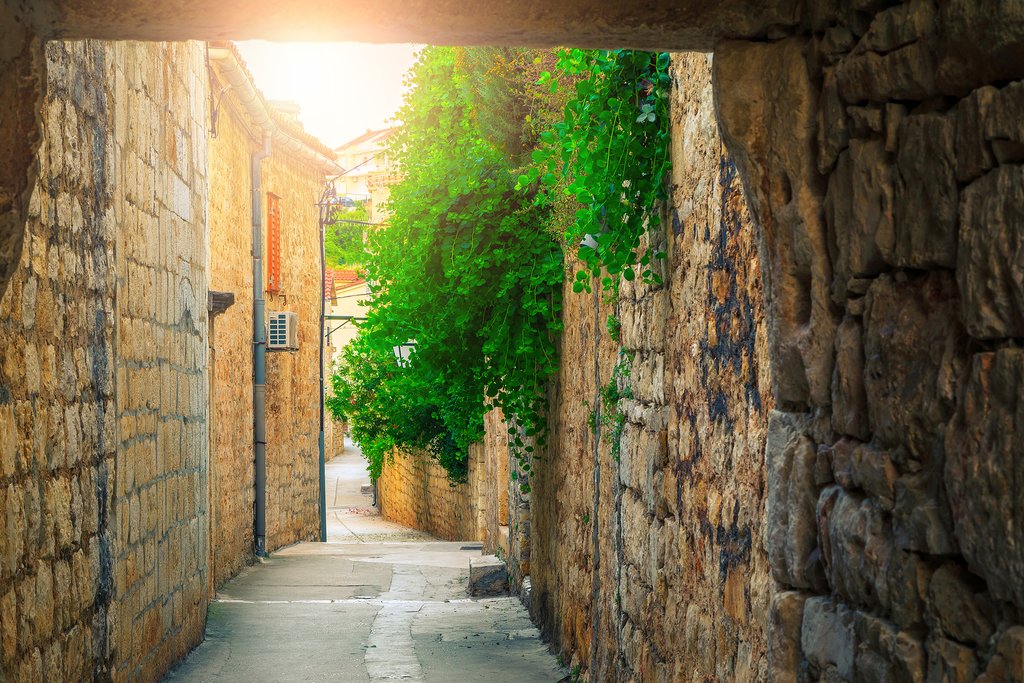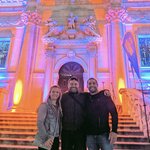Highlights
- Stroll through the medieval streets of Croatia's capital, Zagreb
- Visit Plitvice Lakes National Park and see waterfalls and emerald-green lakes
- Discover Split and learn about its 1,700-year-old history
- Bike across Hvar island and kayak around the nearby Pakleni Islands
- Explore the marble streets and Baroque buildings of Dubrovnik's Old Town
Brief Itinerary
| Day | Highlights | Overnight |
|---|---|---|
| Day 1 | Arrive in Zagreb, Explore | Zagreb |
| Day 2 | Transfer to Plitvice Lakes National Park & Hike | Plitvice Lakes National Park |
| Day 3 | Plitvice Lakes at Sunrise, Transfer to Zadar | Zadar |
| Day 4 | Transfer to Split, Explore | Split |
| Day 5 | Historical Walking Tour of Split | Split |
| Day 6 | Ferry to Hvar, Explore | Hvar Town |
| Day 7 | Afternoon Bike Tour | Hvar Town |
| Day 8 | Ferry to Dubrovnik, Explore | Dubrovnik |
| Day 9 | Historical Walking Tour of Dubrovnik | Dubrovnik |
| Day 10 | Depart Dubrovnik |
Detailed Itinerary
Day 1: Arrive in Zagreb, Explore

Start your adventure in Zagreb, the capital of Croatia. Upon arrival at the airport, you'll be transferred to your hotel to settle in. The rest of the day is yours to spend as you like. The city center is easily walkable, and the streets and parks are easy to navigate on foot. All the main attractions and restaurants are within walking distance.
A gem of a European city, Zagreb is at once historic and new. It's filled with leafy green parks and Gothic/neo-renaissance buildings, yet there are also modern shopping complexes, outdoor malls, and endless dining and drinking options. Consider heading out on a guided walking tour of the historic heart of the city. This involves walking from the main square to Zagreb's Upper Town and passing through local markets before reaching St. Mark's Square.
Alternatively, you can visit one of the many museums and art galleries, like the Homeland War Museum, the Nikola Tesla Technical Museum, or the ever-popular Museum of Broken Hearts. Or stroll through the city center, enjoying 17th-century neo-baroque architecture found at Zagreb's Art Pavilion and Croatian National Theater.
Zagreb also has a number of beautiful city parks, which are great for exploring and people-watching, especially in the late afternoon. Maksimir is a great option, with a variety of cafés nearby to pick up a coffee for your stroll.
Day 2: Transfer to Plitvice Lakes National Park & Hike

Today, you'll make the drive south to Plitvice Lakes National Park, one of Croatia's most popular national parks. Along the way, make a point to stop at Rastoke. Rastoke is a small village known for its old watermills and beautiful waterfalls as two rivers converge in the area. This is a nice precursor of the sights to come at Plitvice Lakes.
A short drive later, you'll arrive at Plitvice Lakes National Park in the early afternoon and can explore the park at your leisure. A must-visit for any traveler to Croatia, the UNESCO-protected park is comprised of an exquisite collection of 16 glassy emerald green and blue travertine lakes, more than 90 cascading waterfalls that seemingly cover every corner of the park and numerous caves. The terraced lakes are surrounded by beech and pine forests and are home to extensive wildlife.
Choose one of eight different hiking trails, ranging from three to eight hours in duration, where the upper lakes tend to be less crowded during the peak season. You may wish to bring a bought lunch (and a bottle of wine!) with you to enjoy a picnic. Tickets are purchased at the entrance of the Park.
Driving time (Zagreb to Rastoke): 1.5-2 hours
Day 3: Plitvice Lakes at Sunrise, Transfer to Zadar

Early morning is one of the best times to visit Plitvice Lakes before the mid-day crowds arrive. You can explore the park on your own or opt for a local guide who will take you on a number of defined routes of varying lengths throughout the park. After enjoying a leisurely morning in Plitvice, carry on your way south to the ancient capital of Zadar, the perfect city to arrive in after a day in the storybook wilderness.
A historical center of the Dalmatian Coast, Zadar is famous for its picturesque coastline full of islands and vibrant blue waters, as well as fresh seafood and unforgettable sunsets. Take the rest of the day to relax and explore. You may wish to stroll along Zadar's Riva, a wide ribbon of stone paths bordered by a grassy park on one side and the sea on the other. It runs along Old Town's waterfront, where it comes alive at night with vendors and Dalmatian acapella groups called klapa that serenade the passersby, including folks on yachts who dock there.
Take in a legendary sunset (Alfred Hitchcock is on record saying they're the best in Zadar) from Café Brazil before discovering the pretty patterned lights of the Monument to the Sun while listening to the nearby Sea Organ.
Driving time: 1.5-2 hours
Day 4: Transfer to Split, Explore

In the morning, continue your drive along the Dalmatian coast and farther south to Split. Upon arriving in Split, check into your hotel and settle into your accommodation before taking the rest of the afternoon to wander Split's historic center.
Start at Pjaca Square for pretty views of white marble tiles, the Iron Gate (the western entrance to Diocletian's Palace), a Romanesque clock tower with the remains of a medieval sundial, and the 15th-century Town Hall. Stop for lunch at Trattoria Bajamont, just north of the Iron Gate. From there, visit the popular Voćnitrg or Fruit Square—a square that got its name from centuries of selling fruit. Here you can enjoy Renaissance architecture influenced during Split's Venetian era. For a bit of shopping and a bite to eat, head to Marmont Street, though you'll want to make your way to the waterfront to catch the sunset. In the evening, take a stroll along Split's seafront Riva to admire the waterfront views.
Driving time (Zadar to Split): 1.5-2 hours
Chat with a local specialist who can help organize your trip.
Day 5: Historical Walking Tour of Split

An ancient coastal city founded 1,700 years ago by Roman Emperor Diocletian, Split's Old Town includes a number of impressive sites, including Peristyle, the Cathedral of St. Dominus, the Piazza, and Diocletian's Palace, one of the best-preserved Roman buildings in the world. Meet your expert guide in Peristyle Square for a walking tour, taking in the 3,500-year-old sphinx Diocletian brought back from Egypt before exploring the 4th-century Diocletian's Palace and other noteworthy sites.
If there's time following your tour, climb the Romanesque bell tower of the Cathedral of St. Dominus (St. Duje)—considered the oldest Catholic cathedral still in use—for stunning views over the city and Adriatic. Another option for great views is to hike or bike to the top of Marjan Hill. Referred to as the "lungs of the city," the entire Marjan peninsula is dotted with tiny centuries-old churches, large cypress and black pine trees, and Mediterranean plants and herbs.
In addition to the stunning vistas, you'll be rewarded with attractions less visited: the Jewish cemetery and 13th and 15th-century churches, St. Nicholas and St. Jerome, respectively. Afterward, head to Bačvice Beach and relax on the sand warmed by the day's sun before choosing a nearby restaurant for dinner.
Day 6: Ferry to Hvar, Explore
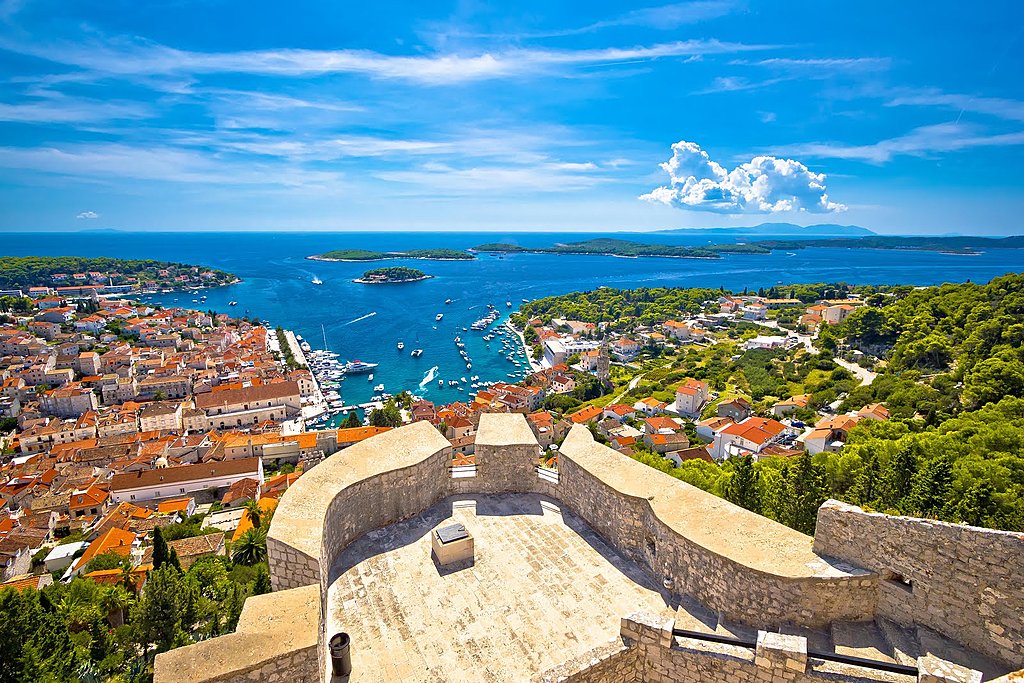
This morning, catch the ferry to the island of Hvar and check into your hotel. A Croatian island in the Adriatic Sea, Hvar is a popular destination with tourists due to its natural setting, mild climate, and its historic port town of the same name. Highlights of Hvar Town include its 13th-century walls, a hilltop fortress, and the main square anchored by the Renaissance-era Cathedral.
For some of the best views of the island, Hvar Town, and the nearby Pakleni Islands, take a short walk up to the 16th-century Španjola Fortress. Or, join a kayaking tour and head out on the Adriatic to discover the many secluded coves that outline the islands. To cover some ground and appreciate the variation in the island landscape: from lavender plantations and olive groves to vineyards and pine woods, you may like to join a (wine-tasting) cycling or hiking tour. The less active might opt to rent a scooter for faster coverage of the local scenery.
After the day's adventures, treat yourself to a drink in the ancient piazza of Hvar, overlooking the Venetian loggia, 7th-century fortification walls, and the oldest municipal theater in Europe.
Ferry time: 1.5-2 hours
Day 7: Afternoon Bike Tour

Take the morning to walk along the Riva to Trg Svetog Stjepana, the long, rectangular square that meets the sea. Here you can visit the Venetian Arsenal and the town theater—one of the oldest Baroque playhouses in Europe. From the square, head into the Groda to explore the Hektorović Palace, Leporini Palace, and the Benedictine Convent.
In the afternoon, transfer from Hvar Town to Stari Grad. Gear up and ready yourself for the cycling tour around the island—the best way to see the whole of the island. You'll bike through the center of well-preserved ancient Greek ruins—a UNESCO World Heritage site—and explore small villages in the inner part of the island.
There are a number of options to choose from, routes ranging from 6 to 9 miles (10-15 km). It'll be an easy ride on mostly flat roads through lavender fields, olive groves, vineyards, palm trees, pine woods, and past coastal villages like Jelsa and Vrboska.
Day 8: Ferry to Dubrovnik, Explore
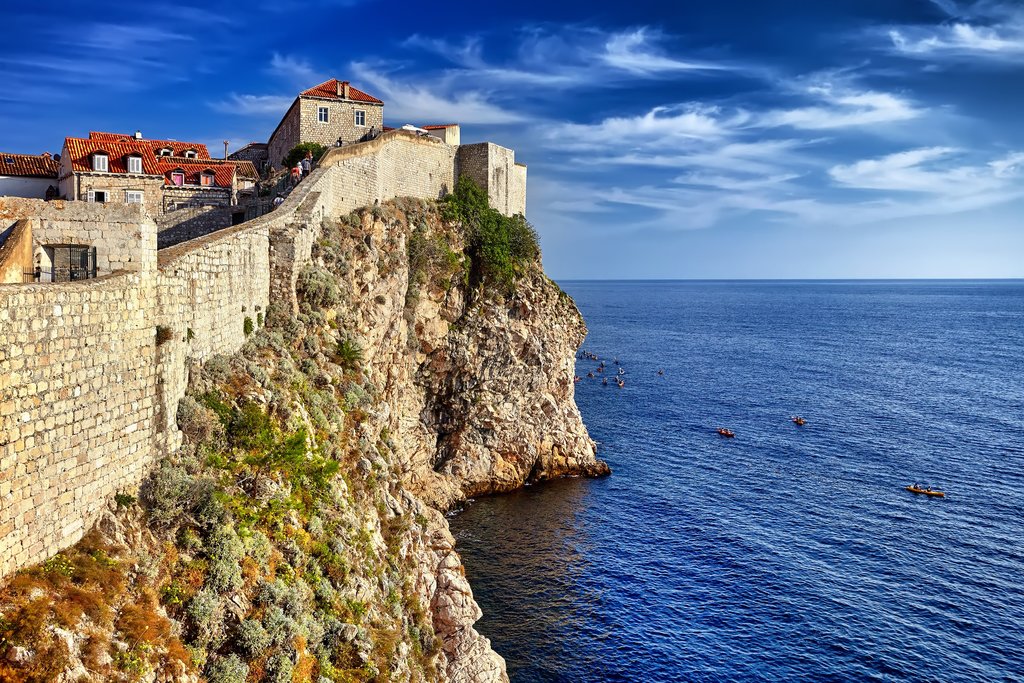
After breakfast, board a four-hour ferry to Dubrovnik. Often referred to as the "Pearl of the Adriatic," Dubrovnik is a world-renowned city of exceptional charm. Take some time to explore its 16th-century stone walls, including the Minceta, Lovrijenac, and Revelin fortresses, visit Onofrio's Fountain and the Church of Saint Blaise (St. Vlaho), and stroll along the limestone-paved Stradun, Dubrovnik's main street to get your bearings. Dubrovnik also offers excellent nightlife and some of Croatia's best restaurants and wine bars.
The remainder of the day will be at your leisure, allowing time for you to wander and explore the city. Depending on when you arrive, you may have time to hop aboard a cable car and ride to the top of Srđ Mountain for stunning views of Dubrovnik and the nearby Elafiti Islands. Here you can explore the 19th-century Fort Imperijal (built during the Napoleonic Wars) before stretching your legs and walking back down the hill, enjoying views of the city below.
Day 9: Historical Walking Tour of Dubrovnik
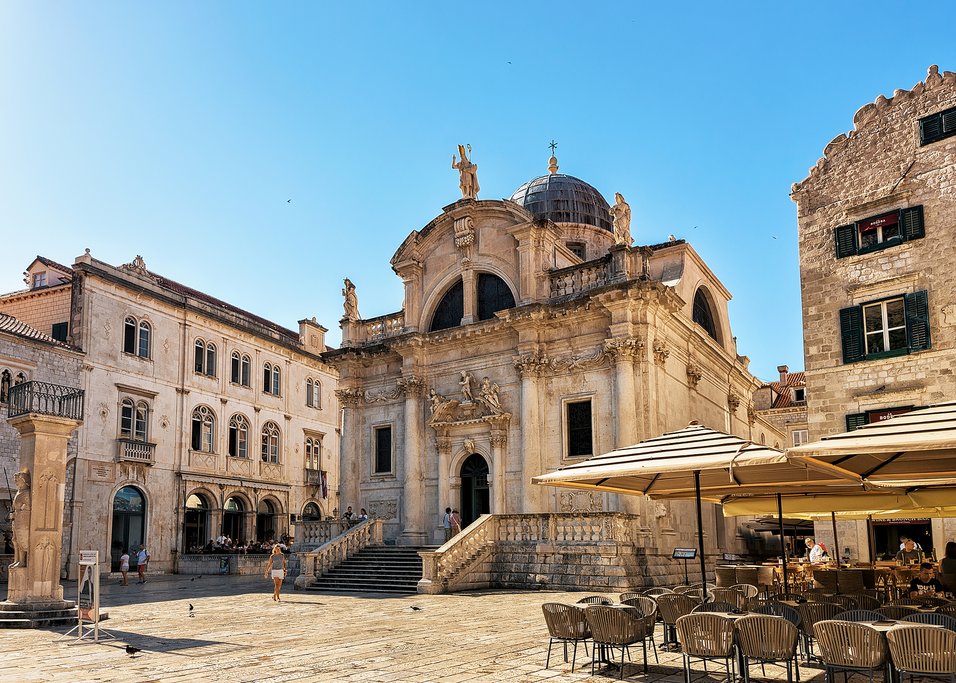
Start your day early (around 8 am) to avoid the crowds and embark on a tour of Dubrovnik, where you'll meet your expert guide outside the entrance to the medieval city at the 16th-century Pile Gate. Entering Old Town, you'll uncover centuries of the city's rich history as you listen to stories of local life and legends and of the importance Dubrovnik once held in the era of the Republic. Highlights include Onofrio's Fountain, the 15th-century Rector's Palace, Luza Square, the Church of St. Blaise (St. Vlaho), and the café-lined streets of Brsalje Street.
After touring the streets and alleys, you'll head for Lovrijenac Fortress as well as the city's impressive defensive walls, the second-largest set of city walls in the world. At certain places, the wall rises 75 feet high, offering excellent vantage points for photos of the coastline.
For the rest of the afternoon, explore Dubrovnik and its surroundings on your own or enjoy the afternoon sun on the nearby beaches. Come early evening; you can get stunning panoramic views over the city and Adriatic by taking the cable car up to Srđ Mountain before descending back down for dinner at one of Dubrovnik's great restaurants.
Day 10: Depart Dubrovnik

Depending on when you depart, you may have time to visit one of Dubrovnik's museums, like the Franciscan Monastery and Museum. This large complex houses many treasures, including the world's third-oldest pharmacy dating from 1317.
Alternatively, for a collection of 15,000 pieces of interesting works, visit the Rector's Palace and Cultural Historical Museum. Wander this well-preserved palace-turned-museum and explore its exhibits, some detailing life in the Republic of Ragusa during medieval times. The drive to the airport from Dubrovnik takes around 45 minutes with normal traffic.
More Great Croatia Itineraries
Looking for more inspiration for your trip to Croatia? Check out these other Croatia itineraries, explore different ways to spend 10 days in Croatia, or discover the best time to visit Croatia.
